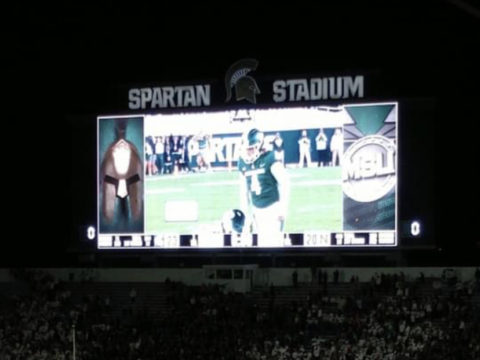
After 128 years of competition, the Big Ten will commence 2024 as an 18-team mega conference.
Of course, the Big Ten recently expanded west to acquire UCLA, USC, Oregon, and Washington from the PAC12, so the Big Ten Conference is now a mega conference with an incredible eighteen teams.
But curiously, the Big Ten decided to drop its divisional format in favor of “open” competition amongst 18 teams. Really?
That seems counterintuitive. Seemingly, expansion should foster divisional alignment, not erase it.
Let’s look at what got us here.
128 years: a brief history.
Big Ten expansion isn’t new in fact it has evolved dramatically over its 128-year history.
The Big Ten was originally conceived as an “academic alliance” in 1896 with just 7 schools. Yet those 7 schools also embraced the notion that athletic competition at the highest level would arguarrly be its most visible symbol of achievement and excellence.
The founders recognized that big time athletics would symbolically be the front porch of their respective universities, and therefore a symbol the public could easily embrace.
They believed in the mantra “a strong mind, strong body, strong spirit” as emblematic of their mission as educators. Indeed, the founders embraced Thomas Jefferson’s famous quote: “a strong body makes the mind strong”.
And so, the Big Ten was conceptualized to foster the best attributes of Academics and Athletics, and 128 years later, the Big Ten is now recognized as the oldest athletic conference in the country and essentially drew a road map for academic and athletic excellencee.
The member schools were originally chartered in 1896 with this somewhat cumbersome title: “Intercollegiate Conference of Faculty Representatives”. Not exactly a catchy title, but it was a forerunner of how the founders intended to balance Academics with Athletics in the healthiest of ways.
As the number of conference schools grew from 7 to 8, to 9, then 10, it adopted several different names including the “Western Conference”, then it became the “Big Nine” and finally the conference officially adopted its current name “Big Ten” in 1951 with the addition of Michigan State.
The conference was originally chartered in 1896 with just 7 schools:
- University of Chicago
- University of Illinois
- University of Michigan
- University of Minnesota
- Northwestern University
- Purdue University…and
- University of Wisconsin
In 1899 the conference expanded to include University of Indiana as well as University of Iowa and thereby increased its membership to 9 schools.
In 1908 Michigan withdrew for seemingly self-serving reasons and the conference reverted to 8.
In 1912, Ohio State was admitted as a member school thereby increeasing the membership to 9 once again.
Then in 1917. Michigan reconsidered its mission and formally resumed its membership in the conference, thereby raising the total to 10 schools although it was still known as the Big Nine.
However, in 1946, Chicago withdrew due to its reticencee to embrace the misssion of collegiate athletics, thereby dropping the conference membership to 9 once again.
Then in 1949 despite loud protest from University of Michigan for seemingly trifling reasons, Michigan State College (now known as Michigan State University) was admitted to the conference, and the membership thereby increased to 10 schools.
And while the conference officially adopted the name Big Ten in 1951, Michigan State didn’t officially commence football until 1953 at which time it won its first Big Ten title.
Expansion in the modern era:
Of course, the Big Ten eventually expanded to twelve teams with the additions of Penn State (1990), and Nebraska (2011).
In that context, it’s notable that Jim Delany, who served as Big Ten commissioner from 1989 to 2020, recognized the need for divisional alignment when the Big Ten reached 12 members.
In fact, Delany advocated for two divisions of 6 teams each and those divisions were designated “Leaders” & “Legends” and they commenced competition in 2011.
Divisional alignment was a pragmatic proposal in spite of its cumbersome and non-descript designation such as Leaders & Legends. Yet, the divisions were segmented as such:
- Leaders: Illinois, Indiana, Ohio State, Penn State, Purdue, Wisconsin
- Legends: Iowa, Michigan, Michigan State, Minnesota, Nebraska, Northwestern
In its original divisional alignment, there were 3 Big Ten Championship games played under the Leaders & Legends alignment, with Wisconsin winning two and Michigan State winning one.
Expansion beckons and Big Ten expands east:
Then Maryland and Rutgers were botth admitted in 2014, and in spite of adding more schools, the Conference retained its official chartered name as “Big Ten”.
Meanwhile, the divisional designation such as Leaders and Legends didn’t sit well with the masses and it was scrapped in favor of a more simplistic and descriptive geographic alignment known as Big Ten East and Big Ten West.
The new alignment included Maryland and Rutgers and 14 teams commenced competition in 2014. The divisions were aligned as such:
Big Ten East: Rutgers, Maryland, Penn State, Ohio State, Michigan, Michigan State and Indiana.
Big Ten West: Purdue, Northwestern, Illinois, Wisconsin, Minnesota, Iowa and Nebraska.
So, we must ask ourselves, if divisional alignment was deemed prudent for 14 teams, then why is it deemed less prudent with 18 teams?
Big Ten Athletics is mega business:
Competition has created unprecedented fan interest and enticed conference expansion amongst all Power 5 conferences.
So, the Big Ten took the next step and poached arguably the 4 most attractive teams from the PAC 12, namely UCLA, USC, Oregon, and Washington.
So, entering 2024, the Big Ten is now comprised of 18 teams, yet there is no mention of divisional alignement.
Really?
But why?
Think about that? 18 teams competing in open format?
That means one false step or one bad loss on a Saturday, especially an early season loss, and your favorite team will be out of the race for a Big Ten title.
But why disregard divisional alignments?
After all, 18 teams sets up perfectly to be segmented into three (3) regional divisions inclusive of six (6) teams each and here is a hypothetical breakout of 3 Big Ten divisions based upon geography:
- Big Ten East: Rutgers; Maryland; Penn State; Ohio State; Michigan and Michigan State.
- Big Ten Midwest: Indiana; Purdue; Northwestern; Illinois; Minnesota and Wisconsin.
- Big Ten West: Iowa; Nebraska; UCLA; USC; Oregon; Washington
In the hypothetical scenario I sketched out, the two power divisions would arguably be the Big Ten East and Big Ten West, yet don’t rule out Wisconsin and Illinois as primary competitors from the Midwest.
After all, Wisconsin has been one of the most consistent teams in the country over the last 30 years and looms as an ongoing threat on any given Saturday, especially under the guidance of Luke Fickell who made magic by improbably guiding Cincinnati, a non-Power 5 school, to the College Football Playoffs.
Meanwhile, Bret Bielema who won the first two Big Ten Championship games as Wisconsin Head Coach, is now coaching Illinois so he understands the lay of the land and looms as a threat to spoil victory celebrations for a fair number of Big Ten opponents regardless of the alignment.
At the minimum, divisional competition enables more teams to stay in the title hunt longer…and that means more fan interest, and that means more media revenue…and that’s the name of the game, isn’t it?
Professional sports got the memo and embraces the economics.
Look at how major league sports have segmented their teams into “micro” divisions thereby optimizing competition, enhancing fan interest and most importantly, increasing TV revenue.
As you peruse the divisional alignment embracedd by professional sports (immediately below), I argue the Big Ten might want to take a cue from professional sports that divisional alignment enhances competitiona and fan interest. Take a look:
MLB:
MLB has 30 teams segmented into six divisions which includes 3 divisions of 5 teams each. Both the American League and National League are segmented into 3 divisions (East, Central and West) of 5 teams each.
NBA:
The NBA has 30 teams segmented into six divisions, including 3 divisions of 5 teams in both the East and West conferences.
NHL:
The NHL has 32 teams segmented into four divisions. Those 32 teams are segmented into the Eastern Conference and Western Conference, and each include 2 divisions of 8 teams each.
And of course, the NFL:
For its part, the NFL has 32 teams divided into two conferences including the AFC and NFC and each of those conferences are divided into 16 teams segmented into 4 divisions with just 4 teams each.
Here is a breakdown of NFL Divisional alignment:
- AFC East: Buffalo Bills, Miami Dolphins, NE Patriots, NY Jets
- AFC South: Houston Tex, Indianapolis Colts, Jax Jaguars, Tenn Titans
- AFC North: Baltimore Ravens, Cinci Bengals, Cleveland Browns, Pitt Steelers
- AFC West: Denver Broncos, KC Chiefs, LV Raiders, LA Chargers
- NFC East: Dallas, NY Giants, Phila Eagles, Washington Commanders
- NFC South: ATL Falcons, Carolina Panthers, NO Saints, Tampa Bay Bucs
- NFC North: Chi Bears, Detroit Lions, GB Packers, Minn Vikings
- NFC West: AZ Cardinals, LA Rams, SF 49ers, Seattle Seahawks
So, I would argue, Big Ten Football should take its greatest cue from the alignment of the NFL.
It’s notable that in the preceding NFL alignment, at least 20 teams were still in the NFL Championship hunt midway thru last January…and isn’t that what everyone wants?
So, if MLB has 6 divisions of 5 teams each, and NBA has 6 divisions of 5 teams each, and NHL has 4 divisions of 8 teams each, and NFL has 8 divisions of 4 teams each, then why in the world would the Big Ten forego Divisional alignment in favor of open format for 18 teams which would arguably eliminate an estimated 14-15 teams from the titele hunt by the start of November?
It’s befuddling really.
At the bottom line: Is Big Ten divisional alignment yet to come?
At this point, it looks cut and dried and that means 18 Big Ten teams will compete in “open” format in 2024 and into the near future, and that means arguably 14-15 teams will be eliminated from Big Ten championship contention before the first week of November.
I think it’s important to remember the dynamic divisional expansion of the NFL from essentially 2 divisions of 6 teams each in 1950, to 32 teams segmented into 8 divisions of just 4 teams each today, but here are those 12 teams that formed the NFL in the early 1950’s:
NFL East:
- New York Giants
- Philadelphia Eagles
- Pittsburgh Steelers
- Cleveland Browns
- Chicago/St Louis Cardinals
- Washington Redskins
NFL West:
- Baltimore Colts
- Detroit Lions
- Green Bay Packers
- Chicago Bears
- LA Rams
- SF 49ers
In my view, it’s interesting to note how the NFL, guided by demographics, media markets and economics, has evolved from just 12 teams in 1950, segmentedd into two divisions of 6 team each, to 32 teams today, segmented into 8 divisions with just 4 teams each.
In fact, I would argue the NFL has essentially segmented into “micro” divisions of 4 teams each, yet those divisions enhance competition and fan interest.
So, I argue “open format without divisonal alignment” does not enhance fan interest or competition but rather stifles it.
In any case, let’s hope Big Ten Commisioner (Tony Petitti), Big Ten AD’s, the Big Ten Network and a host of networks and streaming services, reconsider the misguided logic that has chosen to commence 2024 with 18 teams’ in “open” competition, while a more pragmatic proposal would be a divisional alignment of say 3 divisions of 6 teams each, thereby enabling more teams to stay in the title hunt for longer.
Thank you for reading and I always welcome your comments and opinions.






